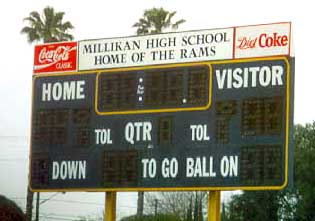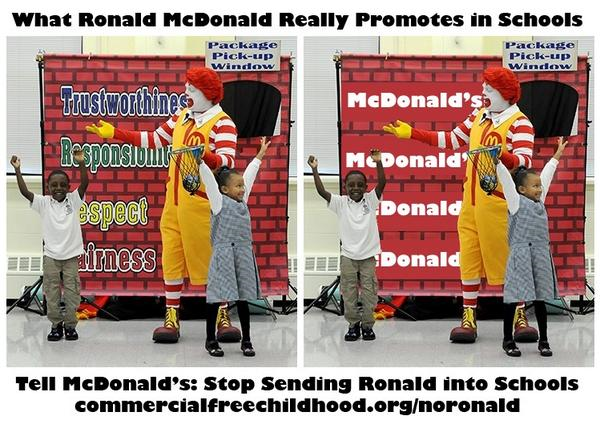The “3 Rs” have now become the “4 Rs,” with the fourth R being “retail”.
A massive infusion of marketing messages bombards school students everyday.
Billboards in school hallways carry advertisements, sports events are sponsored, commercial radio is piped in and in the US an ‘educational’ television channel carries commercials. Corporate logos and advertisements appear on buses, scoreboards, posters and videos. Corporations sponsor contests, literacy programs, reading projects and communications skills training. There are even companies that sell space on textbook covers and exercise book covers to advertisers.
Corporations began targeting their marketing messages directly to children during the 1980s, as affluent adult markets became saturated with consumer goods. Large firms established ‘kids’ departments and smaller firms specialised in marketing to children. A number of advertising industry publications were created such as Selling to Kids and Marketing to Kids Report. The academic literature began to feature studies of children as consumers.
Not only are there many more advertisements aimed at children but they are increasingly infiltrating the private and public spaces where children play and learn. Today’s children are confronted with advertisements almost everywhere they go, at any time. And schools are no refuge from the marketing aimed at children.
Public relations firms and marketers began targeting school education in a big way in the 1990s in the English speaking world. Today there is a corporate stampede to get commercial messages into schools through ‘educational’ resources whilst potential customers are very young. Businesses seek to sell their goods to children, develop brand loyalty now and into the future and improve their image.

Kid Power Winter '05 Conference Brochure excerpt
A regular topic at conferences on marketing to children is “Using schools as a marketing channel to reach kids”.
Reference: Quoted in Michael F. Jacobson and Laurie Ann Mazur, Marketing Madness, Boulder, Colorado, Westview Press, 1995, p. 21.
It isn’t enough to just advertise on television... You’ve got to reach kids throughout their day—in school, as they’re shopping at the mall... or at the movies. You’ve got to become part of the fabric of their lives. Senior vice president of Grey Advertising |
Reference: IQPC, 'Conference Brochure', Kid Power Market Research 2002, Holiday Inn Victoria, London, 23-24 July, 2002.
Kids spend half their lives in school – and they are consumers there. Assess how kids understand the marketing process and how to use it to advantage or circumvent it within the school environment. Kid Power Market Research conference in London in 2002 |
 Schools have been seduced into opening their doors to commercialism because they are desperate for funds (see school funding).
The shortage of funding, prompted in no small part by the unwillingness of corporations to pay their taxes, is encouraging schools to allow those same corporations to turn schools into yet another advertising and marketing venue.
Schools have been seduced into opening their doors to commercialism because they are desperate for funds (see school funding).
The shortage of funding, prompted in no small part by the unwillingness of corporations to pay their taxes, is encouraging schools to allow those same corporations to turn schools into yet another advertising and marketing venue.
School administrations are trying to fill funding gaps with advertising, sales and sponsorship dollars and to fill resource gaps with corporate resources designed for commercial rather than educational purposes. In the process, the health, well-being and critical abilities of school children are being undermined in the name of education.
Schools are an attractive environment for advertisers because they are relatively “uncluttered” – there are not thousands of other advertisements so the few advertisements stand out more and will attract more attention. What is more, because children have to attend school and pay attention when they are there, they are a “captive” audience – they can’t change channels or stations and are not distracted by other things going on. Parents are not present to act as gatekeepers. Advertisers also gain from the positive association with education and the implied endorsement and tacit approval of educational authorities and teachers for their messages.

The effects of advertising on children are exacerbated in schools because students are a captive audience and because the advertisements have “the implied endorsement” of teachers and the school in general.
The corporate infiltration of the school buildings and curriculum is training students to be consumers and corporate supporters rather than citizens with a capacity for critical thought. In a limited curriculum, the more business/consumer oriented material there is the less alternative material there will be.
Commercialism in schools also undermines the motivations for learning by offering material rewards for educational achievements:
It associates success, happiness, and well-being with getting an external reward. It undermines the sense of internal satisfaction that comes from figuring out or learning something new on one’s own in a creative and unique way—the heart of successful learning in schools. It reduces children’s interest in finding and working on problems of their own making as well as feeling the sense of personal empowerment that comes from doing so.
Moreover, the more dependent a school is on corporate funds the less likely they will be to teach students “to question the means and motivations of business.”
George Gerbner notes that with advertising and commercialism infiltrating every aspect of life, education has been – until now – “the only large-scale institutional corrective capable of reordering priorities and cultivating within students some sense of detached, analytical skill”. But this is being undermined by the increasing infiltration of schools by corporations. True education stimulates “a skeptical and critical view” whereas corporations promote their products rather than illuminate.
Similarly Michael J. Sandle argues in The New Republic:
Advertising encourages people to want things and to satisfy their desires: education encourages people to reflect on their desires, to restrain or to elevate them. The purpose of advertising is to recruit consumers; the purpose of public schools is to cultivate citizens... Rather than raise the public funds we need to pay the full cost of educating our schoolchildren, we choose instead to sell their time and rent their minds to Burger King and Mountain Dew.
Schools that allow commercial messages “reinforce the idea that the production and consumption of goods is the essence of individual happiness and civic obligation”. They also encourage children to judge each other by their possessions and to value peer opinion above that of teachers.
The irony is that whilst advertising and public relations material is taking up more and more of the school day, advertisers are starting to fear that this may affect literacy and the ability of consumers to read their advertisements. An article in Brandweek was subtitled: “Lower academic standards affect ability of marketers to reach consumers.”
If you have any examples or updates you would like to contribute please email them to me and I will add them here. Please give references for where you sourced the information.